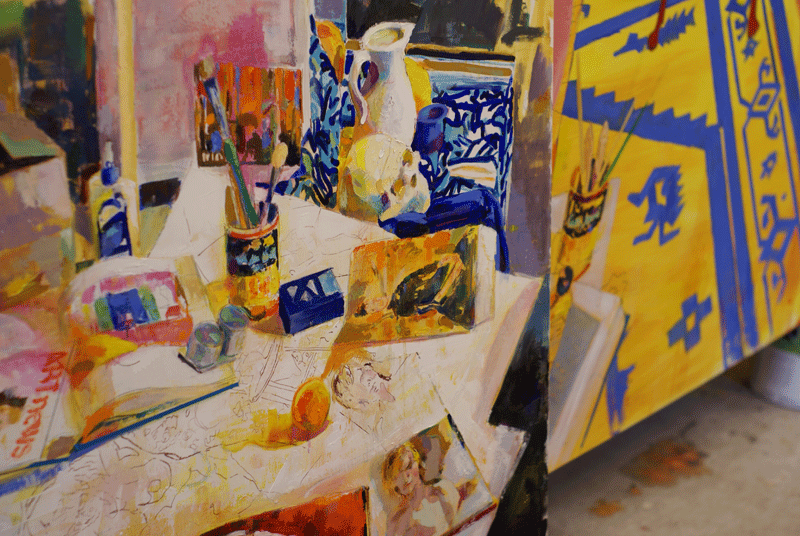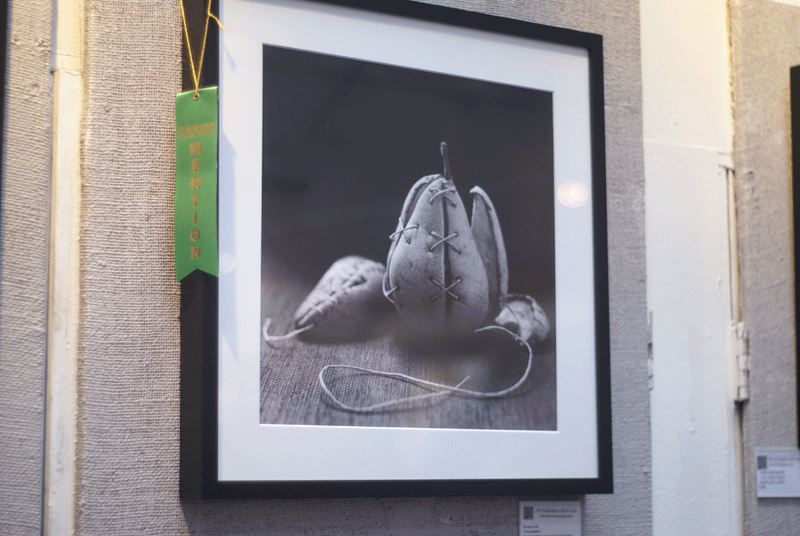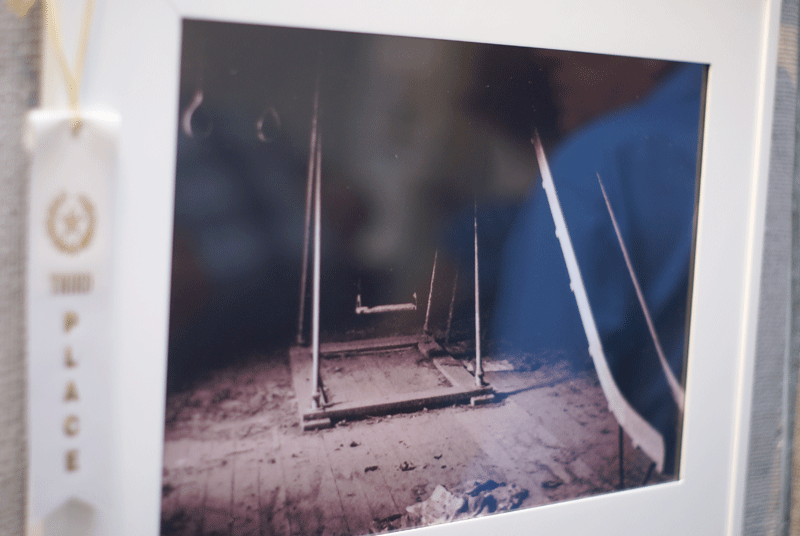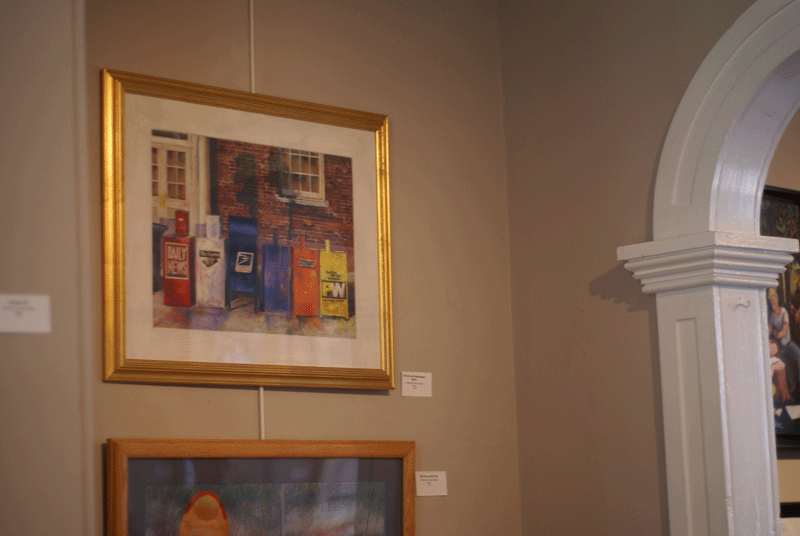 Bruce Garrity, Studio Visit, Rutgers-Camden, Recent Work, detail of large painting, photograph by Jeff Stroud
Bruce Garrity, Studio Visit, Rutgers-Camden, Recent Work, detail of large painting, photograph by Jeff Stroud
Bruce Garrity, Studio Visit, Rutgers-Camden, Recent Work
“I am really into architectonic, geometric abstract art like Sangram Mujamdar. He’s a really good painter, he’s Indian, American, teaches at MICA, you would probably like his work. I don’t know that I’m influenced by him but he’s somebody who is a contemporary, and I think my work somehow relates to his and what he’s doing. it’s also that they are representational that I like about them. There’s a few people around like that, Gideon Bok in Boston, they are more about perception.”
 Bruce Garrity, Studio Visit, Rutgers-Camden, Recent Work, photograph by Jeff Stroud
Bruce Garrity, Studio Visit, Rutgers-Camden, Recent Work, photograph by Jeff Stroud
The studio on the Rutgers campus has high ceilings, big widows, rolling lockers and space to paint big. Bruce Garrity‘s paintings are big, really big. So big that when he show’s them he has to rent a moving van. But the flexible space isn’t crowded and I didn’t notice any paint smell so I guessed the vivid paintings were acrylic.
“No, these are all oil paintings. We don’t use very much turpentine and usually what you smell is turpentine, I don’t use it very much. There are some passages that are sort of washy, but they were painted a while ago. I don’t use a lot of medium, I use a little bit of this alkyd because I need them to dry. But normally, I don’t even put any of that into it, it’s the oil paint, it’s thick, but it’s just the paint.”
I like using Liquin, but it smells. It’s good for outdoors but my studio smells like fumes.
“I just use a little and then the smell goes away after a day or two. In here it’s gotten to the point where we don’t use that much. My students have one can that they all wash their brushes in and that’s about it. We go though maybe a quart of turpentine per semester.”
I’ve been using Gamsol to clean my brushes.
“Some people say that’s a problem because you just don’t smell it, there’s still fumes in the air. There’s a school of thought that it’s better if it smells a little bit because then you’re aware of it in the air. We use a little of it so there’s not a lot of it in the air.”
 Bruce Garrity, Studio Visit, Rutgers-Camden, Recent Work, photograph by Jeff Stroud
Bruce Garrity, Studio Visit, Rutgers-Camden, Recent Work, photograph by Jeff Stroud
Bruce, you’re canvasses are huge, I struggle with just small ones.
“You know, it’s the scale. The scale that I’m comfortable with is essentially life-size at the picture plane. So, if I make a figure, the whole figure is six feet tall. So, it really has to do with the scale more than anything else. I like big paintings, too. But they’re a pain in the ass. You have to have to right space for them. But, you know, it’s how I like to paint. It is what it is.
That big one out there, the one that’s in the other room. That was a completely different painting in 1995. I showed it down here in the Stedman Gallery and it had a big dinosaur, and a jeep, and a bunch of other things. It was sort of like a museum/circus vibe, I was big into that back in the 90s. I kept it, because obviously no one was going to buy it. So at one point I just white-washed the whole thing.
Towards the end of the time that I was in graduate school that’s when I started to paint landscapes. I painted pretty heavily because I was in graduate school and I started do this waterfall bit that is kind of like what I would see up in the Poconos when we went on vacation. And then I started putting these figures in, kind of like Cezanne’s Large Bathers, it’s kind of like the Large Bathers of the Poconos.”
 Bruce Garrity, Studio Visit, Rutgers-Camden, Recent Work, photograph by Jeff Stroud
Bruce Garrity, Studio Visit, Rutgers-Camden, Recent Work, photograph by Jeff Stroud
Do you have people model for you?
“Some of them are. Either from models who were here. some are taken from drawings, photographs, a bunch of different stuff. Some are the top half might be one person and the bottom half might be someone else. They’re kind of Frankenstein-ed together, I don’t know that I would normally do that, but, that is basically how Cezanne did his. For a guy who was basically known as a perceptual painter, always painting what was in front of him, all the Bathers paintings, he made tons of them, were all from out of his head or old sketches. I think he even did some of them out of fashion magazines that his sister had. So, he was imagining girls with their clothes off, I guess.
Apparently, he was like nervous around models. It wasn’t like he never had nude models, but they made him nervous-er. I always thought that was really interesting, and everybody I always talks about the stuff that he did, looking at it perceptually, but going forward, the Cubists looked at those paintings and that’s where they got permission to do what they did. It was like, ‘He can do it. Why can’t we?'”
 Bruce Garrity, Studio Visit, Rutgers-Camden, Recent Work, photograph by Jeff Stroud
Bruce Garrity, Studio Visit, Rutgers-Camden, Recent Work, photograph by Jeff Stroud
Will you be showing this at your show at 3rd Street Gallery?
“Oh, yeah. It will probably be about twenty paintings. There are seven or eight big things, and a bunch of little things. We will be showing in the annex as well and there are some spots the smaller pieces will look well. I’m showing with Katherine Kurtz, she does some abstract things, some are more figurative. I would say she’s mainly an abstract painter but here she’s showing more figurative, DeKooning-ish, kind of figurative things.
The pairings at 3rd Street Gallery are kind of random, but sometimes you get these connections that are interesting. I’m looking forward to it, I like Katherine a lot. I like her work. And my work doesn’t always play well with others, they’re overwhelming and colorful and big. But I think our things are going to look good together.”
 Bruce Garrity, Studio Visit, Rutgers-Camden, Recent Work, photograph by Jeff Stroud
Bruce Garrity, Studio Visit, Rutgers-Camden, Recent Work, photograph by Jeff Stroud
For any questions regarding the theme or medium, please contact Jeff at jeffstroud.52@gmail.com












 Judy Sawicki, Still Waters, oil,
Judy Sawicki, Still Waters, oil,  Joyce McAfee,The Dune, watercolor,
Joyce McAfee,The Dune, watercolor,  Maureen Gass-Brown, Traveling Light, pastel water colors,
Maureen Gass-Brown, Traveling Light, pastel water colors, 